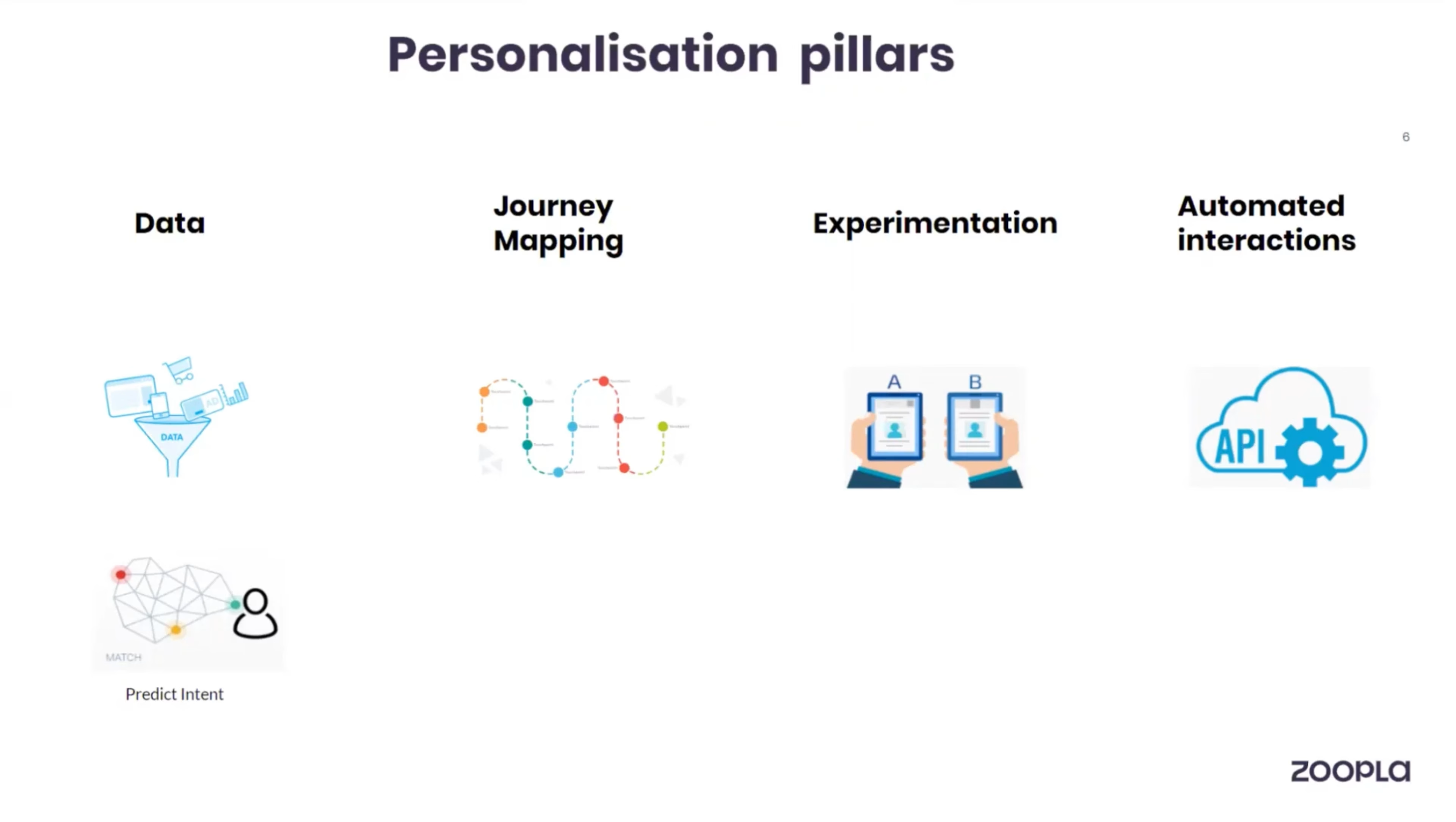The company
Zoopla is a British residential property software, data, and insight company founded in 2007.
As Head of Analytics at Zoopla, Veronica leads a team of analytics specialists. Her role is wide-ranging from strategy to product and infrastructure projects to assembling a high-performing team and providing them with the resources they need.
The challenge
With six years of experience at Zoopla under her belt, Veronica has seen the company evolve and is now focusing on the next phase of its analytics journey. “We’ve spent a lot of time over the last few years building the analytics infrastructure at Zoopla,“ says Veronica.
“Now we’re in the position where we can leverage data for personalization. To do this, we’ve implemented platforms like Optimizely and Contentsquare. Both platforms allow us to personalize our digital journey, making the experience intuitive, simple, and clear so users can move through our portal seamlessly.”
Why is personalization so important?
A personalized experience isn’t just a nice to have—today’s customers have become accustomed to personalized interactions with the brands they know and love.
“Consumers expect to be recognized across devices whether that’s on the web or apps. They also expect to be able to interact 24/7, whenever it best suits them. Brands that are already doing this well have raised the level of expectation among consumers,” says Veronica.
First and foremost, Veronica says personalization is about making user experiences more enjoyable, which in turn can have a massive impact on engagement and brand loyalty. “As a user, if you experience a product that’s delightful, easy-to-use, and tailored to you, you’re more likely to come back.”
And this has a direct impact on retention and customer acquisition costs. “If you have a good retention rate, then you don’t have to work as hard to acquire customers over and over again,” says Veronica. “Positive brand interactions create a flywheel—when you give your customers a great experience, they’ll come back for more and you’ll get to understand them better. This customer data then allows you to build more relevant experiences.”

Using Contentsquare and Optimizely has provided our digital teams with easy, quick access to data insights and removed bottlenecks from our analytics and experimentation processes.

The solution
Zoopla’s personalization strategy is based on four main pillars: data, journey mapping, experimentation, and automation. Veronica breaks down each step and how it’s helping her team create a solid foundation for personalization.

Zoopla's personalization pillars
Pillar 1: data
The first step for Zoopla is bringing clarity to how they collect and use customer data.
“In a cookieless world, first-party data is becoming more and more important. So we’re focused on building trust and being transparent about how that data is used.”
When it comes to using data for personalization, Veronica believes that making every touchpoint in the customer journey personalized isn’t possible. “As much as we want to, we can’t tailor every single interaction on the website. So we try to be extremely deliberate when applying personalization—only using it where it makes sense for the customer, to enhance their experience and strengthen their relationship with Zoopla.”
Pillar 2: journey Mapping
Journey mapping enables the team at Zoopla to understand where personalization needs to be applied, what the best action for the customer is, and how to develop products down the line. “The key is having a comprehensive, single view of the customer, where we have a repository of user data and an understanding of our digital journeys and usage across devices,” says Veronica.
Part of Zoopla’s journey mapping process involves using segments within Contentsquare’s Journey Analysis.“The process of buying a house can take months or even years. So knowing where buyers are in their journey is important—whether someone is just browsing or actually ready to apply for a mortgage,” says Veronica. “Segments help make this possible—it’s a very flexible and versatile tool.”
Example of Contentsquare's Journey Analysis capability
Pillar 3: experimentation
At Zoopla, personalization is rooted in testing. The team has created a culture of experimentation and takes a test-and-learn approach to optimization to create the best digital experience for their visitors.
“Experimentation helps us improve both our products and services,” says Veronica. “Hypothesis testing has been built into our product development and we’re able to test at a user level and audience level.”
Pillar 4: automated interactions
The final piece of the puzzle is automation, which works “behind the scenes” to connect the data from Zoopla’s portal to their other platforms, such as email. “The three other pillars wouldn’t deliver value without automated workflows, like APIs, where you take all this customer intelligence and deploy it to your digital channels,” says Veronica.
Technology is the foundation of each personalization pillar, helping the team at Zoopla implement their strategy. “Our analytics stack is really important because it helps us segment and personalize the entire journey across devices and platforms,” shares Veronica.
Product managers and designers can experiment using Contentsquare and Optimizely without needing support from data analysts. They’re able to self-serve; if they have an idea, they can test it themselves.

Combining unique customer insights in Contentsquare and Optimizely
Using the Contentsquare and Optimizely integration, teams across Zoopla can combine unique customer behavior insights with experimentation capabilities. “The integration gives everyone across our digital teams access to quick insights,” says Veronica.
Not only does the integration provide easy access to insights, it also allows their analysts, product owners, and designers to be more efficient. “Without a complicated data process, our people can focus on the job they need to get done, freeing up time for brainstorming and creating hypotheses,” explains Veronica.
What's next?
“Now that we have our technical set-up in place, we’re focused on analyzing, iterating, and testing—because like with anything, it’s unlikely you’ll get it right the first time around. For our personalization strategy to be truly successful, we need to go back and continuously test,” says Veronica.
The next step for Zoopla also includes scaling its strategy across all its digital channels. “It’s one thing to run a small experiment or introduce personalization, but we need to learn how to use data in better ways, like with machine learning,” says Veronica.
“We’re looking to scale personalization so that we could, for example, take proprietary information such as postcode data to make the user journey more intuitive.”
When it comes to personalization and their roadmap to success, Veronica says it’s all about how you define success: “I think we’ve already achieved success by making this happen and bringing it to life. Now we’re focused on succeeding in the next stage of our personalization journey.”



